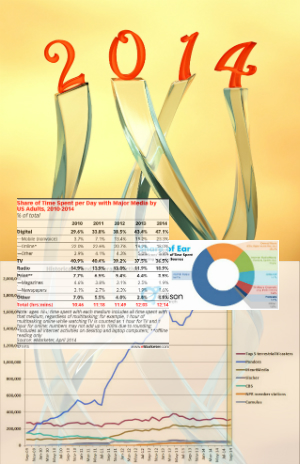 Studies, surveys, and metrics abounded in 2014. RAIN News readers demonstrated acute interest in research which attempted to tease out trends in the fast-changing field of streaming audio. Selected reference points below.
Studies, surveys, and metrics abounded in 2014. RAIN News readers demonstrated acute interest in research which attempted to tease out trends in the fast-changing field of streaming audio. Selected reference points below.
In March, Edison Research and Triton Digital combined to produce the 2014 edition of The Infinite Dial, a survey of online listening behavior among Americans. The overall story could be described in one word: Growth. audience growth, brand recognition growth of music services, growth of mobile listening, growth of in-car listening. RAIN News covered The Infinite Dial in five installments:
- The growth of online listening: Nearly half of all Americans listened to online in the past month.
- In-car listening: Plugging smartphones into the dashboard was a behavior on the upswing from the previous year.
- Brand recognition: Over 25% of Americans recognized five music service brands, with several other services gaining significant recognition.
- Mobile listening: 500% growth in smartphone ownership over five years, and Pandora dominates the download wars.
- Music discovery: AM/FM competes with Pandora, YouTube, and many other online sources for the music discovery needs of Americans.
Speaking of brand recognition, in Harris Interactive released its brand equity study in March, calling particular attention to streaming audio services for their positive brand awareness growth.
Triton Digital’s monthly drumbeat of numbers is the Webcast Metrics Top 20 Ranker, showing the volume of streaming for Triton’s most active subscribers. They include major radio groups, Pandora, Slacker Radio, AccuRadio, and others. The broad marker in the tangled trendlines of the top-20 group is eight percent growth in webcasting year-to-date (January to September, the most recently measured month).
In May, SNL Kagan released the 2014 edition of Economics of Internet Music & Radio, which projected the growth of advertising revenue in streaming audio, forecasting a 10-year surge from $880-million to $3.2-billion. The report predicted advertising revenue trends for broadcast, too, with a gentler growth curve.
In June, Edison Research came back to market with the first installment of a new survey called Share of Ear, which sought to measure how much Americans listened to all sources of audio — CDs, terrestrial radio, streaming audio, satellite, podcasts, and even TV music channels. Streaming audio took nearly 12% percent of the total “ear.”
When Viacom issued survey results of under-40 listeners in August, the headline was “Streaming is the new normal” — 78% of respondents had streamed music in the past month.
How does streaming music affect music sales? A study by the Country Music Association discovered that respondents were more likely to purchase music after hearing it streamed, than after hearing it on broadcast radio.
TuneCore’s November survey of musicians seemed to corroborate the CMA results. TuneCore found two-thirds of survey subjects saying that streaming services make it easier to discover their songs.
